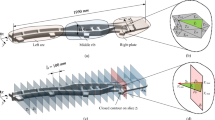Abstract
In multistage hot forging processes, the preform shape is the parameter mainly influencing the final forging result. Nevertheless, the design of multistage hot forging processes is still a trial and error process and therefore time consuming. The quality of developed forging sequences strongly depends on the engineer’s experience. To overcome these obstacles this paper presents an algorithm for solving the multi-objective optimization problem in designing preforms. Cross wedge rolled preforms were chosen as subject of investigation. An evolutionary algorithm is introduced to optimize the preform shape taking into account the mass distribution of the final part, the preform volume and the shape complexity. A crucial factor in preform optimization for hot forging processes is the amount of flash. Therefore an equation for improving the amount of flash is derived. The developed algorithm is tested using two connecting rods with different shape complexities as demonstration parts.





















Similar content being viewed by others
References
Behrens B-A, Nickel R, Müller S (2009) Flashless precision forging of a two-cylinder crankshaft. Prod Eng Res Dev 3:381–389. doi:10.1007/s11740-009-0185-x
Guan Y et al (2014) Preform design in forging process based on quasi-quipotential field and response surface methods. Procedia Eng 81:468–473. doi:10.1016/j.proeng.2014.10.024
Li Q, Lovell M (2008) Cross wedge rolling failure mechanisms and industrial application. Int J Adv Manuf Technol 37(3–4):265–278. doi:10.1007/s00170-007-0979-y
Pater Z, Tomczak J (2012) Experimental tests for cross wedge rolling of forgings made from non-ferrous metal alloys. Arch Metall Mater 4:919–928. doi:10.2478/v10172-012-0101-9
Kache H, Stonis M, Behrens B-A (2012) Development of a warm cross wedge rolling process using FEA and downsized experimental trials. Prod Eng Res Dev 6:339–348. doi:10.1007/s11740-012-0379-5
Li Q et al (2002) Investigation of the morphology of internal defects in cross wedge rolling. J Mater Process Technol 125–126:248–257. doi:10.1016/S0924-0136(02)00303-5
Behrens B-A et al (2013) Basic study on the process combination of deposition welding and subsequent hot bulk forming. Prod Eng Res Dev 7(6):585–591
Blohm T, Stonis M, Behrens B-A (2015) Investigation of simulation parameters for cross wedge rolling titanium and bainitic grade steel. Appl Mech Mater 736:165–170
Cakircali M, Kilicaslan C, Güden M, Kiranli E, Shchukin V, Petronko V (2013) Cross wedge rolling of a Ti6Al4 V (ELI) alloy: the experimental studies and the finite element simulation of the deformation and failure. Int J Adv Manuf Technol 65:1273–1287. doi:10.1007/s00170-012-4256-3
Neugebauer R, Lorenz B, Steger J (2009) Cross wedge rolling to preform light metal forgings. Met Matter 12:13
Tofil A, Tomczak J, Pater Z (2013) Cross wedge rolling with upsetting. Arch Metall Mater 58:1191–1196. doi:10.2478/amm-2013-0150
Bartnicki J, Pater Z, Gontarz A, Tomczak J (2014) Innovative metal forming technologies. J Mach Eng 14:5–16
Meyer M, Stonis M, Behrens B-A (2015) Cross wedge rolling and bi-directional forging of preforms for crankshafts. Prod Eng Res Dev 9:61–71. doi:10.1007/s11740-014-0581-8
Hatzenbichler T, Buchmayr B (2008) Vorformoptimierung für das Gesenkschmieden mittels numerischer Simulation. BHM Berg-Huettenmaenn Monatsh 153:413–417. doi:10.1007/s00501-008-0422-1
Mirsaeidi M et al (2009) Optimum forging preform shape design by interpolation of boundary nodes. In: Proceedings of the world congress on engineering, vol 2
Behrens B-A, Nickel R, Stonis M (2012) Simulation algorithm for the assessment and modification of multi-directional forging processes and tool gemoetries. Prod Eng Res Dev 6:187–198. doi:10.1007/s11740-012-0364-z
Shao Y, Lu B, Ou H, Ren F, Chen J (2014) Evolutionary forging preform design optimization using strain-based criterion. Int J Adv Manuf Technol 71:69–80. doi:10.1007/s00170-013-5456-1
Ciancio C, Citrea T, Ambrogio G, Filice L, Musmanno R (2015) Design of a high performance predictive tool for forging operation. Procedia CIRP 33:173–178. doi:10.1016/j.procir.2015.06.032
Landkammer P et al (2016) A non-invasive form finding method with application to metal forming. Prod Eng Res Dev 10:93–102. doi:10.1007/s11740-016-0659-6
Goldberg D (1989) Genetic algorithms in search, optimization and machine learning. Addison-Wesley, London
Haupt RL, Haupt SE (2004) Practical genetic algorithms. Wiley, Hoboken
Acknowledgments
The authors thank the German Research Foundation (Deutsche Forschungsgemeinschaft) for the funding of the research project “Entwurf optimaler Vorformstufen zum Herstellen von Schmiedebauteilen unter Anwendung von stochastischen Optimierungsverfahren” (DFG Be 1691/177-1 and DFG OV 36/22-1). The authors thank the Hammerwerk Fridingen GmbH for the support in this project.
Author information
Authors and Affiliations
Corresponding author
Ethics declarations
Conflict of interest
The authors declare that they have no conflict of interest.
Rights and permissions
About this article
Cite this article
Knust, J., Stonis, M. & Behrens, BA. Preform optimization for hot forging processes using an adaptive amount of flash based on the cross section shape complexity. Prod. Eng. Res. Devel. 10, 587–598 (2016). https://doi.org/10.1007/s11740-016-0702-7
Received:
Accepted:
Published:
Issue Date:
DOI: https://doi.org/10.1007/s11740-016-0702-7




